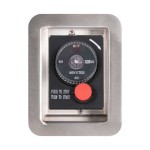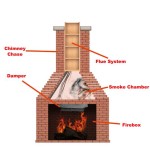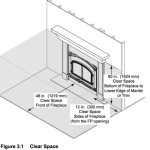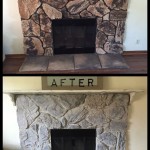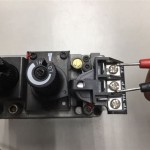How High Should a TV Be Mounted Over a Gas Fireplace?
Mounting a television above a gas fireplace is a popular design choice that combines entertainment and ambiance. However, determining the optimal height for the television is critical for both viewing comfort and the longevity of the electronic device. Several factors influence the ideal placement, including viewing distance, the size of the television, the height of the fireplace, and potential heat exposure. Ignoring these considerations can lead to neck strain, distorted viewing angles, and potential damage to the television from excessive heat. This article will explore the key considerations for properly mounting a television above a gas fireplace.
Understanding Viewing Angle and Ergonomics
The primary goal when mounting a television is to ensure a comfortable and ergonomic viewing experience. This relates directly to the viewing angle. The ideal viewing angle is typically considered to be with the center of the screen at or slightly below eye level when seated. This position minimizes neck strain and allows for extended viewing sessions without discomfort. To determine the appropriate height, one must first establish the typical viewing distance. This is the distance between the seating area and the wall where the television will be mounted. A longer viewing distance generally allows for a slightly higher mounting position, whereas a shorter viewing distance necessitates a lower placement.
The size of the television also plays a role. A larger television, while offering a more immersive viewing experience, may require a higher mounting position to ensure the entire screen is visible comfortably. Conversely, a smaller television might appear dwarfed and awkwardly positioned if mounted too high. Therefore, it is essential to consider both the viewing distance and the television's size in conjunction to determine the most ergonomic mounting height.
Beyond these factors, the height of the fireplace itself influences the optimal television placement. The fireplace acts as a visual anchor, and the television should typically be positioned in a way that maintains a balanced aesthetic. Mounting the television too close to the top of the fireplace can create a cramped and visually unappealing look. Leaving adequate space between the top of the fireplace and the bottom of the television ensures a more visually pleasing and balanced arrangement. Furthermore, one must factor in the height of the mantel, if present, and its proximity to the television screen. A protruding mantel may obstruct the lower portion of the screen if the television is mounted too low.
Addressing Heat Concerns and Ventilation
One of the most critical considerations when mounting a television above a gas fireplace is the potential for heat damage. While gas fireplaces produce less radiant heat than traditional wood-burning fireplaces, they still generate considerable heat that can negatively impact the television's delicate electronic components. Excessive heat can lead to reduced lifespan, screen discoloration, and even complete failure of the television.
To mitigate the risk of heat damage, it is imperative to implement strategies that minimize heat exposure. The first line of defense is to ensure adequate ventilation. Proper airflow around the television allows heat to dissipate more effectively, preventing it from accumulating and damaging the internal components. This can be achieved by leaving sufficient space around the television, particularly at the top and sides, allowing for natural convection. Consider installing a floating shelf above the fireplace, which allows space for heat to freely rise above the fireplace rather than directly blasting the back of the TV.
A mantel can also act as a heat shield, deflecting rising heat away from the television. A deeper mantel provides more effective protection. However, even with a mantel in place, it is crucial to monitor the area above the fireplace during extended use. If the area feels excessively warm to the touch, additional measures may be necessary. Heat sensors can also be installed to monitor the temperature above the fireplace and provide an early warning if the temperature exceeds safe levels. These sensors can be programmed to send alerts to a smartphone or trigger an audible alarm, allowing for prompt intervention to prevent potential damage.
Consider the fireplace's BTU (British Thermal Unit) output. A fireplace with a higher BTU rating produces more heat, increasing the risk to the television. In such cases, a higher mounting position and enhanced ventilation are even more critical. Some homeowners opt to install a specialized heat deflector above the fireplace to redirect heat away from the television. These deflectors are typically made of metal and are designed to channel heat forward and away from the wall. Ultimately, the selection of the appropriate mounting height necessitates a careful balance between viewing comfort and the need to protect the television from heat damage.
Practical Installation Considerations and Alternative Solutions
Before commencing the installation process, it is essential to thoroughly assess the wall structure. The wall must be capable of supporting the weight of the television and the mounting bracket. Locating wall studs is crucial to ensure a secure and stable installation. Use a stud finder to accurately identify the position of the studs. If the studs are not ideally spaced for the mounting bracket, a bridging board can be installed across multiple studs to provide a solid mounting surface. Avoid mounting the television solely to drywall, as it lacks the structural integrity to support the weight safely.
When selecting a mounting bracket, choose one that is specifically designed for the size and weight of the television. There are various types of mounting brackets available, including fixed, tilting, and full-motion brackets. A tilting bracket allows for adjusting the vertical viewing angle, which can be beneficial when mounting the television higher than ideal. A full-motion bracket provides even greater flexibility, allowing for adjusting the television's angle in multiple directions. This can be particularly useful in rooms with multiple viewing areas.
In some cases, mounting the television above the fireplace may not be the most practical or aesthetically pleasing solution. Alternative options include mounting the television on an adjacent wall or using a freestanding television stand. These alternatives allow for a lower and more ergonomic viewing position while eliminating the risk of heat damage from the fireplace. Consider these options if the fireplace design or room layout makes mounting the television above the fireplace impractical. When considering alternatives, factor the natural light from windows and doors to avoid glares on the television screen. Some alternative options include a swivel mount, located next to the fireplace, that can be adjusted to fit the viewing angle depending on the time of day. Careful planning and consideration of all factors are essential to ensure a safe, comfortable, and enjoyable viewing experience.
In summary, determining the correct height for mounting a television above a gas fireplace is a multifaceted process that requires careful consideration of viewing ergonomics, heat management, and installation practicalities. Prioritizing these aspects will lead to a more enjoyable and safe home entertainment setup.

Can I Mount A Tv Over My Fireplace Forshaw Of St Louis

Can I Mount My Tv Above The Fireplace

Can I Mount A Tv Over My Fireplace Warming Trends

Mounting Your Tv Above Fireplace

Can I Mount My Tv Above The Fireplace

Can You Put An Electric Fireplace Under A Tv And Minimum Distance

Should A Fireplace Be Bigger Than The Tv Solved Tips

Installing A Tv Above The Fireplace

ᑕ❶ᑐ Is It Safe To Put A Tv Above Fireplace Safety

Mounting A Tv Over The Fireplace Common Myths Busted Cepro


